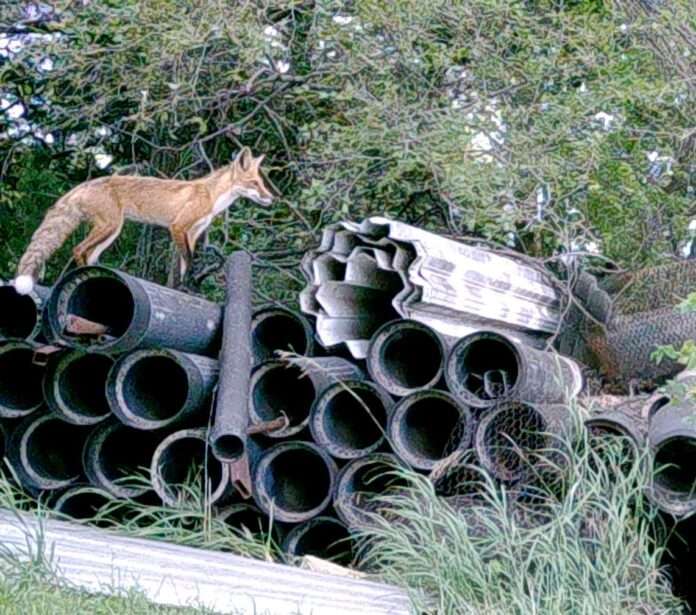I turned onto the street that runs in front of our home in the quiet, sleepy, little town of Inman, KS. I hadn’t driven more than fifty feet, when out from between two neighbors’ houses trotted a canine that was not a dog. The long, bushy tail with a white tip held straight out behind as it sauntered across the street, gave it away as a red fox. I followed it as it crossed the grade school parking lot, walked across the front lawn of the school, then crossed the street into a neighboring yard, never spooked and merely strolling along.
A few years back, a pair of red foxes called Inman home for awhile until the den was found and everybody and their brother began showing up to sneak a peek, at which point the foxes moved on. I had heard some were again being seen around town, and was glad for the show. Red foxes live in many of our small Kansas towns, having found all they need there for good, safe lives away from marauding coyotes that will kill them given the chance.
One of my editors who runs a monthly outdoor page suggested I do a column entitled “When wild animals encroach on your yard and eat stuff they shouldn’t.” Welcome to spring in the Kansas outdoors when all the critters are on the prowl around chicken coops, corrals and even backyards looking for quick, easy meals to feed dens and nests full of youngins.’ This time of the year emboldens predators to hunt and prowl during the day when they would otherwise never think of it.
Like springtime on the farm, springtime in the wild is a season filled with babies everywhere. It is no coincidence that there is more prey available in the form of young, easily caught critters at this time each year, just exactly when every wild animal needs extra prey to feed its young. Isn’t it amazing how everything seems to come full circle back to the fact that God knew exactly what He was doing when he engineered the order of things! Even with the glut of easily caught “wild” lunches right now, predators are still opportunists at heart and will not think twice about grabbing a young farm animal or even cats, kittens and small dogs if given the chance. As spring turns into July and August, increased predation seen in the spring will slow again, but in the meantime, there are a few extra precautions that can be taken to at least make the opportunists think twice about grabbing’ something from the coop, corral or backyard.
Even though you can’t keep an eye on poultry and young farm animals 24/7, giving them a place under roof to spend the night will help dramatically. Giving poultry a place to spend the night behind a closed door is a good thing any time of the year. Remember, despite their willingness to prowl more during daylight right now, a predator’s favorite time to hunt is still after dark. Keeping the grass and weeds mowed and trees pruned around pens will help also, as removing any cover predators can use to sneak close to a barn, chicken house or yard will help deter their presence. Sadly, there’s not a lot that can be done in town to deter predators aside from keeping cats, dogs and chickens within a fenced yard or enclosure of some sort.
Playing a radio and keeping a couple lights lit in the barn where sheep and goats spend the night will sound like human activity to a predator and can help deter their presence. The most effective predator prevention is probably a good watch dog, even if it’s small. Dogs of any size make predators nervous, and even though any coyote, bobcat or raccoon worth its salt can easily overpower most small dogs especially if they catch them out in the open, a noisy little mutt relentlessly yapping away at them as they slink around the barn or sheep pen might at least make them question their plan, and will likely alert you in the process. Unfortunately, a yappy little dog will probably not work well in town, as it will probably keep you in hot water with the rest of the neighborhood.
Yup, its spring time in the Kansas outdoors again, and all the critters and predators have families to feed and might “Encroach on your yard and eat stuff they shouldn’t” as they follow their God-given instincts to protect and feed their young. Don’t get me wrong, I’m not condoning that, after all, I’m a coyote trapper. But I am saying that understanding why it happens helps me look at it from a slightly different perspective. …. Continue to Explore Kansas Outdoors!
Steve can be contacted by email at [email protected].





